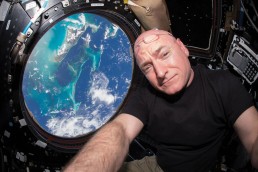Specialist Node > Space Physiology and Medicine
Changes in brain fluid pressure in astronauts can adversely impair their vision while in space. Our research group, headed by the Lion’s Eye Institute Director Professor William Morgan, uses pulse wave properties of the eye’s blood vessels to estimate pressures in the brain fluid.
Vision in Space
We have been studying the relationship between brain fluid pressure, also known as intracranial pressure (ICP) and the eye for some 20 years. Recently, with collaborations with neurology and neurosurgery, we have found that the pulse waves that travel along the blood vessels at the back of the eye are produced by and travel from the brain fluid.
This discovery allows us to use sophisticated mathematical and imaging techniques to measure these pulse waves and infer the ICP. Until now, ICP could only be measured by drilling a hole through the skull and into the brain or passing a needle into the lower back, both of which are quite invasive, prone to some risks and tend to be rarely performed.
ICP is known to rise to unsafe and vision altering levels in astronauts who are in space for more than six months. However, ICP is known to also play an adverse role in head injury recovery, brain tumours, optic nerve swelling and glaucoma.
We are currently refining this technique to make it useful in hospitals and clinics as well as potentially in space. The need for a small size and fast analytical speed in space should accelerate its development as an important health tool on earth.
In space, we anticipate that this breakthrough will allow regular monitoring of astronaut ICP and allow testing of treatments to reduce or eliminate dangerous elevations in ICP. In parallel, we are working on techniques that should favourably alter orbital and ICP that can be applied in space.


